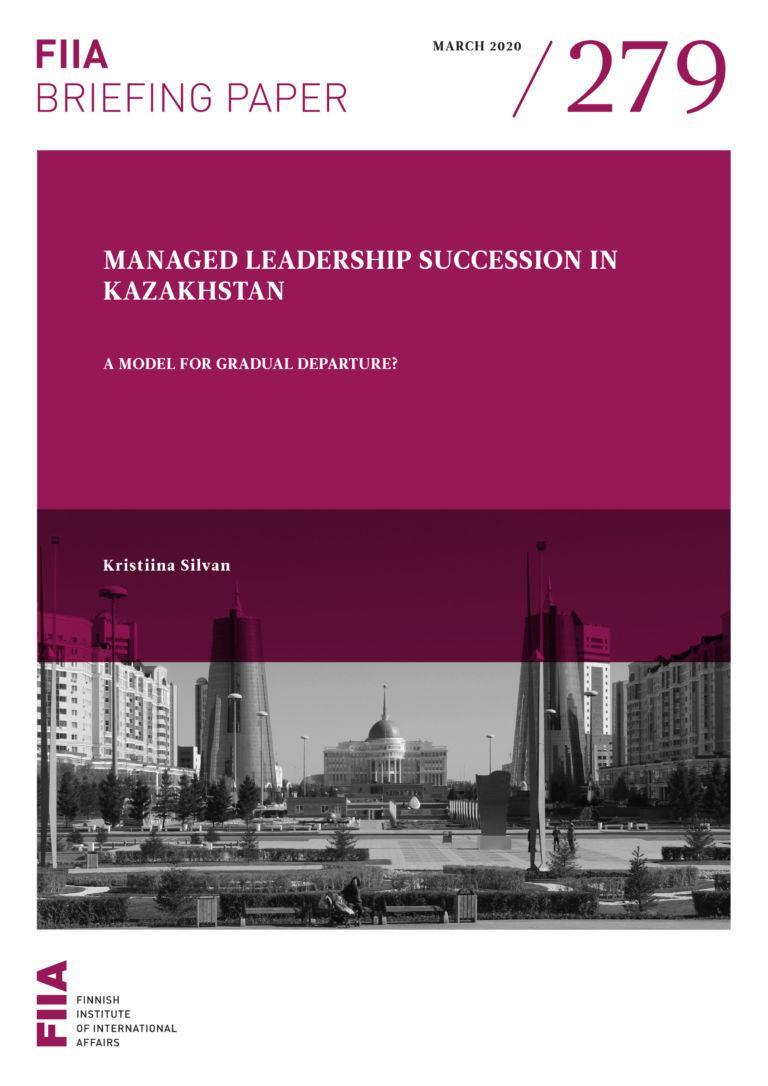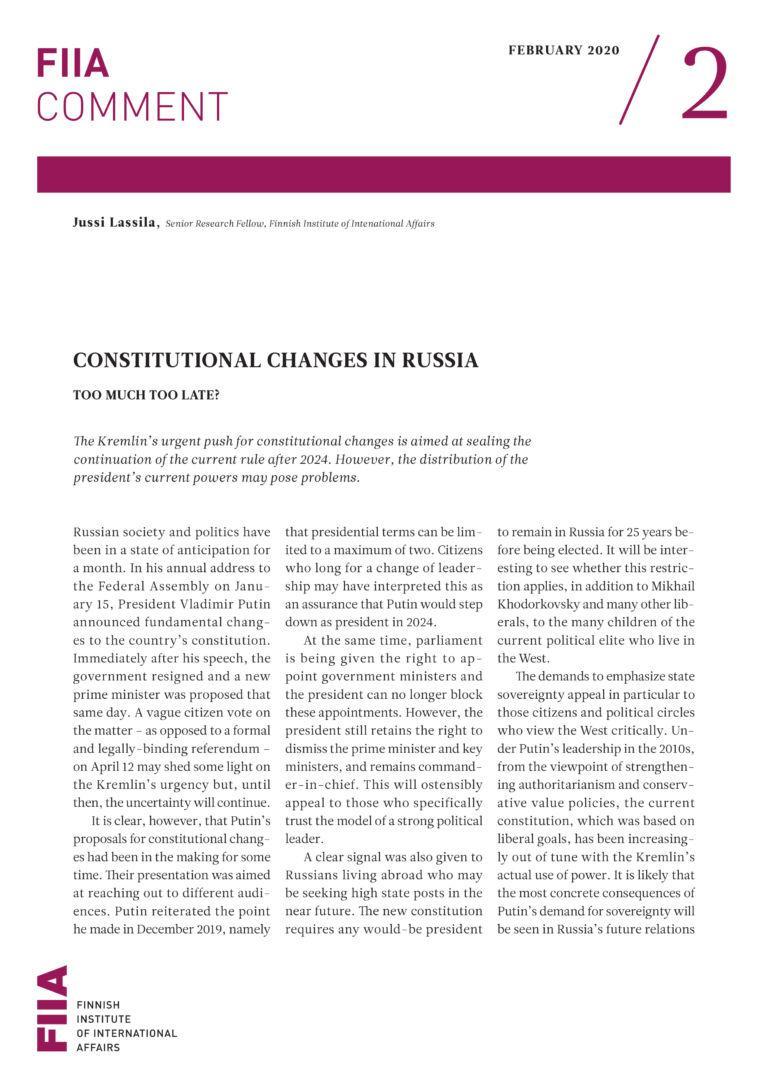
- In March 2019, Kazakhstan’s authoritarian leader, Nursultan Nazarbayev, stepped down after three decades of rule and yielded power to his nominated successor, Kassym-Zhomart Tokayev. However, Nazarbayev has paradoxically remained the most powerful political actor in Kazakhstan.
- Kazakhstan’s model of gradual leadership succession could serve as an example to authoritarian states around the world, but it is particularly significant in the post-Soviet context.
- Institutional and constitutional changes that took place in the 1990s were aimed at concentrating power in the presidency.
- Modifications initiated by Nazarbayev in the 2000s and 2010s sought to weaken the Kazakh presidency while strengthening power vested in himself personally, in order to ensure the continuation of a political status quo and his family’s well-being after the transfer of power.
- Despite the careful preparation and Tokayev’s relatively smooth ascension to power, it is still too early to evaluate the success of the transfer due to the vast powers retained by Nazarbayev. The transition of power in Kazakhstan remains an ongoing process and, as such, unpredictable.
Introduction
In March 2019, Kazakhstan’s 78-year-old President Nursultan Nazarbayev surprised the world by announcing his resignation after thirty years of rule. The decision made him one of the very few authoritarian leaders who after years of consolidating power would step down voluntarily. However, it immediately became clear that although Nazarbayev was resigning as president, he would not be stripped of power. Thanks to the various posts acquired by him in the 2010s, Nazarbayev has paradoxically remained the most powerful political actor in Kazakhstan after his resignation. What seems to be unfolding in Kazakhstan is the first succession taking place in the post-Soviet space under full control of an incumbent who is not leaving the scene.[1] As such, it is certain that other senior autocrats in the region and beyond are keeping a close eye on how the succession is proceeding.
In personalist authoritarian states like Kazakhstan, leadership succession is problematic. Positions of leadership are institutionally powerful and the systems of checks and balances are weak, so much is at stake. Unlike democracies, autocracies lack transparent and accepted rules of succession. As a result, times of leadership succession tend to generate an internal struggle within the ruling elite. Political instability, for its part, propels economic and societal instability that can have unexpected outcomes not just for the country in question but also for the wider region. Moreover, autocrats thinking about stepping down might consider it wise to act otherwise. Giving up power, even partially, automatically weakens the ruler’s position and can potentially lead to the ruler’s swift and complete downfall. Upon losing power, the former rulers could face charges linked to their likely misconduct in office. Considering these issues, it is no accident that many authoritarian leaders prefer to die in office rather than cede power during their lifetime.
What makes authoritarian leadership successions particularly challenging in the post-Soviet world is the relative novelty of the states concerned. Kazakhstan never existed as an independent nation state prior to 1991, and since independence it has never been ruled by anyone other than Nazarbayev. Russia’s military interventions in Georgia and Ukraine have demonstrated that from the Russian perspective, post-Soviet borders are not set in stone. Northern Kazakhstan hosts a sizeable ethnic Russian minority, albeit shrinking, that could hypothetically serve as a pretext for Russian uninvited involvement in Kazakhstan. From the perspective of the sovereignty of the Kazakhstani state, the desire for a managed leadership succession duly has an existential quality. No less meaningful is the transition from Soviet to post-Soviet leadership. Nazarbayev, born in 1940, is the last Soviet party boss still in power in the post-Soviet world. The natural exit of his generation will inevitably shape the future of Kazakhstan’s politics.
This Briefing Paper analyzes the ongoing transfer of power in Kazakhstan. It demonstrates that the Kazakhstani leadership succession was a carefully orchestrated operation that has until now unfoldedavourably for Nazarbayev and his family. Nazarbayev’s nominated successor, career diplomat Kassym-Zhomart Tokayev, has thus far offered Kazakhstan’s politics more continuity than change. As a result, Kazakhstan’s experiment in a gradual transition of power can serve as a valuable example for other autocrats in the region. However, due to the vast powers retained by Nazarbayev upon his resignation as well as the potentially powerful presidency, the transition of power in Kazakhstan remains an ongoing process and, as such, unpredictable. The concluding section analyzes the risks inherent in the transition of power in the current post-resignation period.
1990s: Consolidating presidential power
The political development of Kazakhstan in the 1990s is a classic case of the consolidation of personalist authoritarian rule. Nursultan Nazarbayev ascended to power in Kazakhstan in 1989 when the country was still a part of the Soviet Union. On the eve of Kazakhstan’s independence in December 1991, his position as the country’s president was confirmed in an uncontested popular election.
The Constitution of 1993 structured Kazakhstan as a semi-presidential system of government. The constitution gave the legislative and the judicial branches considerable powers to balance and control the executive branch headed by the President, whose time in office was limited to a maximum of two five-year terms. However, following a clash between the market reform-oriented President Nazarbayev and a predominantly communist parliament in 1994, Nazarbayev dissolved the parliament and, in March 1995, created a new representative body of Kazakhstan’s ethnic groups, the Assembly of the Peoples of Kazakhstan, the delegates of which he appointed personally. The Assembly called for a nationwide referendum on the extension of the President’s term in office (set to expire in 1996), which took place in April 1995 and unconstitutionally allowed Nazarbayev to remain president until 2000.
After that, another nationwide referendum was organized just four months later, in August 1995. On the agenda was a proposal to introduce a new constitution, which turned Kazakhstan into a super-presidential republic. According to official figures, the new constitution was approved by 90% of voters. One of the most notable results of the constitutional reform was the abolishment of the Constitutional Court, formerly a check on both the executive and the legislative. In 1998, constitutional amendments increased the presidential term from five to seven years, raised the lower age limit for candidates to 40 years, and eliminated the upper age limit, previously set at 65. In addition, the 2000 presidential election was brought forward, which, some argue, enabled Nazarbayev to secure a victory despite the financial turbulence generated by the 1998 financial crisis.[2] According to international observers, the elections of 1999 failed to meet the standards of free and fair elections, as had all of the other elections before then.
In July 2000, a new constitutional law granted Nazarbayev the status of “the First President”, which provided him with significant privileges and competences even after retirement from presidential office. In particular, he was to remain the life-long Chair of the Assembly of Peoples of Kazakhstan and a member of the Constitutional and the Security Councils. Moreover, a constitutional amendment of 2007 stipulated that the restriction of two presidential terms in a row would not apply in the case of the First President, who could be re-elected infinitely.
2000s: Dynastic succession considered and rejected
The constitutional amendments adopted in the 1990s enabled the centralization of power in the hands of the institution of the president. In contrast, what took place in the 2010s was an institutional rebalancing that increased the power of Nazarbayev personally. Between these two phases, in the 2000s, Kazakhstan witnessed the consideration and rejection of dynastic succession. In the former Soviet Union, managed hereditary succession has been successfully implemented in Azerbaijan, where President Heydar Aliyev handed over power to his son Ilham in 2003.
Nazarbayev has three daughters, two of whom were discussed as potential successors in the 2000s.[3] The president’s eldest daughter, Dariga Nazarbayeva, and her influential entrepreneur husband, Rakhat Aliyev, entered the political spotlight in 2003. However, for reasons unknown to the general public, Nazarbayev soon withdrew his support from the couple. The two divorced in 2007, and Aliyev faced charges of corruption and murder. Aliyev applied for asylum in Austria, but committed suicide in 2015, before the case went to trial. Since then, Dariga has returned to politics, serving as deputy prime minister, as well as a member and Chair of the Kazakh Senate, the upper house of the country’s bicameral parliament. Some commentators insist that she may run for the presidency after Tokayev, while others argue that she can never be seen as a legitimate ruler in Kazakhstan’s patriarchal society. For the time being, her rise to the presidency remains unlikely, although as the head of the Senate, she is now formally the number two in Kazakhstan’s political hierarchy.
Nazarbayev’s second daughter, Dinara, is married to oil and gas oligarch Timur Kulibayev, whose net worth was estimated at $3.5 billion. Some political analysts argue that Nazarbayev did regard Kulibayev as his presidential heir after Aliyev fell from grace, but changed his mind after the 2011 Zhanaozen events that left 16 protesting oil workers dead and 100 injured. Kulibayev might plausibly nurture an ambition to rule Kazakhstan after Tokayev, but since he lacks widespread support among the Kazakh ruling elite, this outcome is not considered likely.[4]
2010s: Limiting the power of the successor
After deeming dynastic transition a failure, Nazarbayev proceeded to prepare for a gradual succession that he himself would oversee. The planned transition was to have two preparatory components. First, Nazarbayev hoped to secure the future well-being of his family, in both political and financial terms. Second, the president aspired to weaken the Kazakh presidency while strengthening power vested in himself personally, in order to manage the political succession as well as transform the personalist system into a more collegial form of authoritarian rule.
Whereas it was Singapore that set an example of a succession model to follow, Kazakhstan’s eastern neighbour Uzbekistan demonstrated elements that Nazarbayev apparently hoped to avoid. In 2016, Islam Karimov, the Uzbek president that had ruled the country since its independence, died of a cardiac arrest. Karimov passed away without a designated successor, which generated a split within the Uzbek elite. As a result of elite negotiations behind closed doors, the prime minister of 13 years, Shavkhat Mirziyoyev, was appointed – not formally in line with the constitution – the acting president. To consolidate his power, Mirziyoyev proceeded to appoint his supporters to key government positions, while ousting his potential rivals – some of whom had enabled his accession to the presidency. In 2018, Karimov’s widow and both daughters were targeted in a corruption case.[5] Since Nazarbayev would plausibly hope to protect his family and avoid elite infighting after his departure, there is reason to believe that he does genuinely seek to transfer power to his successor during his lifetime.
In fact, Nazarbayev took the first steps to safeguard his family as early as 2010. This was when the parliament of Kazakhstan granted Nazarbayev the title of leader of the nation (Elbasy in Kazakh), which is not purely symbolic as it provides Nazarbayev and his family with immunity from criminal prosecution for life. However, this cannot be considered a full guarantee. In neighbouring Kyrgyzstan, for example, the former president, Almazbek Atambayev, has been stripped of his ex-president status and thus of immunity from persecution after a conflict with Sooronbay Jeenbekov, his selected successor.
After rejecting plans for hereditary succession, Nazarbayev has ostensibly been playing his potential successors off against one another, ensuring that none of them would gain a clear lead.[6] The strategy makes sense from the perspective of the political science literature, which demonstrates that the members of the regime’s elite pose the greatest threat to authoritarian leaders, especially those who are growing weaker. For this reason, Nazarbayev cannot and does not fully trust his elites. In 2016, a major cabinet reshuffle took place, followed by a fierce campaign against corruption that witnessed a sweeping wave of arrests of high-ranking officials. In 2018, a new law restricting the outflow of capital from Kazakhstan’s banks was introduced, supposedly to keep the Kazakh oligarchs in check.
A major step to weaken the Kazakh presidency while strengthening Nazarbayev’s powers independently of his office was the constitutional reform of 2017. Perhaps surprisingly, there was no nationwide referendum on the amendments, but a Soviet style “popular discussion” instead, lasting for one month. The amendments that were introduced gave government ministers more power to manage the economy and social issues, while increasing parliamentary control over the government by giving members of the parliament the right to hold votes of confidence in the cabinet. The president, for his part, retained control over foreign policy, national security, and defence, while remaining as the supreme arbiter in state affairs.
Nazarbayev’s strategy was to anchor his political power in a plethora of institutions across the three branches of government. He became the Chair of Nut Otan, Kazakhstan’s party of power, upon its establishment in 2007, and has remained in the position ever since. Retaining control over the party is important since it dominates the Kazakh parliament. In the executive sphere, Nazarbayev has been appointed lifetime leader of the country’s Security Council, which coordinates the implementation of state policy on national security and defence. To ensure his presence in the juridical sphere, Nazarbayev holds lifelong membership of the Constitutional Council.
2019: Stepping down, and after
The posts accumulated by Nazarbayev in the 2000s ensured that he would not be stripped of power after his announced resignation in March 2019. Furthermore, despite the election of his designated successor, Kassym-Zhomart Tokayev, as President, power remained concentrated in Nazarbayev’s hands. To date, Kazakhstan’s first president exercises considerable influence as a member of the Constitutional Council, the Chair of the ruling party Nur Otan, the lifelong head of the constitutional Security Council, and the Elbasy. This institutional safety net stretches across the three branches of government and enables him to play the role of a veto player in Kazakhstan’s state affairs.
Although Nazarbayev did not openly name a successor until his resignation, it can be assumed that the power transfer was prepared rather carefully. In June 2019, Tokayev was announced as the winner of the presidential election which, according to the observers’ mission of the Organization for Cooperation and Security in Europe, had failed to meet democratic standards. Shortly after his election as president, Tokayev claimed that the decision about his designation had already been made in 2015. “It was a matter of time. We were waiting for the [right] moment,” he commented in an exclusive interview with Euronews.[7]
Despite the careful preparation and Tokayev’s relatively smooth ascension to power, it is still too early to view the transition of power as a success for Nazarbayev. The way in which the transfer happened galvanized Kazakhstan’s dormant opposition and civil society, which staged a number of protests in 2019. A completely new youth movement, “Wake up, Kazakhstan!”, emerged as a spontaneous reaction to the successor operation and the renaming of the capital as Nur-Sultan. Although Tokayev responded to the protests with Nazarbayev-style repression, he also endorsed the need for reforms – including in the political sector. This might augur certain changes in the future.
In addition, there is some evidence to suggest that tensions are emerging between the different sub-groups of the Kazakh elite. In October 2019, Tokayev criticized the development of the capital and ordered a corruption investigation into a $1.5 billion light rail project that would target members of Nazarbayev’s inner circle. The following month, he signed a law making ministers and governors directly responsible for corruption among their subordinates, while in December, the acting president reshuffled key government positions. Using corruption cases to harass political opponents is standard practice in authoritarian regimes, while appointing loyalists in positions of power is an essential step in consolidating one’s rule in both democracies and non-democracies. Although Tokayev remains outpowered by Nazarbayev, Kazakhstan’s super-presidential form of government and Nazarbayev’s age are working for the benefit of the current president. As a result, the Kazakh elite could well shift their primary allegiance from Nazarbayev to Tokayev even during the former’s lifetime.
At the same time, however, Tokayev made one major concession that increased the power of the former president. Just one day after ordering an investigation into the light rail project, he signed amendments to the decree “On Certain Issues of the Personnel Policy in the System of Public Administration”. The amendments granted veto power over high-level political appointments to Nazarbayev as the Chair of the Security Council. As a result, Tokayev needs Nazarbayev’s approval for appointments in the presidential administration, the security service, the Prosecutor-General’s Office, and for regional governors. Some analysts have interpreted the decree as an attempt by Nazarbayev to contain his successor.[8]
Conclusion
Nazarbayev’s aim has been to construct a system that allows him to exercise power from various positions that belong to him personally rather than from those that come with the presidential office. This part of his model of gradual succession has prevailed. However, considering that Nazarbayev’s aim is also to ensure Kazakhstan’s political, social and economic stability for the future, the former president is not retreating from power quickly enough. Considering the vast powers vested in Elbasy personally, his departure would create a power vacuum that nobody would be able to fill overnight. In such a situation, Kazakhstan’s elite would have to negotiate a new power-sharing arrangement. Although research shows that such negotiations are usually successful,[9] even a short period of confusion might pose a threat to the political stability of the country. This could in turn lead to economic and social turbulence with unpredictable repercussions. Finally, the future of Nazarbayev’s close circle of friends and relatives remains an open question. At present, Nazarbayev and his family are protected by the title of Elbasy, but due to the omnipresence of corruption,[10] their security and wealth cannot be guaranteed in the future.
Authoritarian leaders in the post-Soviet space and beyond are apparently following Kazakhstan’s experiment with leadership succession closely. The handover of the presidential office took place rather frictionlessly, but it is unclear how the situation will evolve in the future, both during Nazarbayev’s lifetime and after his departure. The way that Nazarbayev, Tokayev, and other members of Kazakhstan’s ruling elite navigate through the transfer of power will provide other authoritarian leaders with material for analyzing both what to avoid and what to push through. In any case, it is the specific local political, social and economic context that will determine the feasibility of different options.
Despite the rearrangement of government institutions as a part of the gradual transfer of power, the leadership succession issue in Kazakhstan has not yet been fundamentally resolved. Only time will tell if and how Nazarbayev’s legacy will be secured and preserved.
Endnotes
[1] The closest parallel to the succession model outside the post-Soviet world – and its potential inspiration – is that of Singapore. Singapore’s authoritarian leader, Prime Minister Lee Kuan Yew, stepped down gradually over the course of the 1990s after ruling the country since the establishment of its self-governance in 1959. It is also notable that Lee’s son, Lee Hsien Loong, has led Singapore since 2004. https://thediplomat.com/2015/03/lee-kuan-yews-singapore-as-a-model-for-kazakhstan/
[2] See e.g. the report by Human Rights Watch (1999) Kazakhstan: Freedom of the Media and Political Freedoms in the Prelude to the 1999 Elections, https://www.hrw.org/report/1999/10/01/kazakhstan-freedom-media-and-political-freedoms-prelude-1999-elections.
[3] For an academic take on the potential for hereditary succession in Kazakhstan, see McGlinchey, E. (2011). Chaos, violence, dynasty: politics and Islam in Central Asia. University of Pittsburgh Press.
[4] Robin Paxton (23 December 2011) “Analysis: Kazakh leader reinforces power with oil sackings” https://www.reuters.com/article/us-kazakhstan-succession/analysis-kazakh-leader-reinforces-power-with-oil-sackings-idUSTRE7BM0M820111223; Bne IntelliNews (24 October 2019) “Power Play in Kazakhstan” https://www.intellinews.com/power-play-in-kazakhstan-nazarbayev-s-iron-rod-glimpsed-in-shadows-170248/. On Zhanaozen, see Dossym Satpayev & Тolganay Umbetaliyeva (2015) “The protests in Zhanaozen and the Kazakh oil sector: Conflicting interests in a rentier state”, Journal of Eurasian Studies, 6(2) https://www.sciencedirect.com/science/article/pii/S1879366515000068#bib19.
[5] Like Nazarbayev, Karimov was originally thought to be preparing his older daughter, Gulnara Karimova, to assume power after him. However, Karimova fell out with the rest of her family in 2007, and a corruption investigation was even launched against her during her father’s lifetime.
[6] Arkady Dubnov (6 February 2017) “Continuity in Kazakhstan: Nazarbayev’s Curious Appeal for Constitutional Reform”, Carnegie Moscow Center, https://carnegie.ru/commentary/67906.
[7] Galina Polonskaya (17 June 2019) “President of Kazakhstan took EU advice on political transformation”, Euronews exclusive interview, https://www.euronews.com/2019/06/15/president-of-kazakhstan-takes-eu-advice-on-political-transformation-euronews-exclusive.
[8] Joanna Lillis (25 October 2019) “Who really is Kazakhstan’s leader of the nation?” Eurasianet https://eurasianet.org/who-really-is-kazakhstans-leader-of-the-nation.
[9] Andrea Kendall-Taylor & Erica Frantz (10 September 2015) “When Dictators Die”, Foreign Policy https://foreignpolicy.com/2015/09/10/when-dictators-die/.
[10] GAN Business Anti-Corruption Portal (July 2016) “Kazakhstan Corruption Report” https://www.ganintegrity.com/portal/country-profiles/kazakhstan/.







